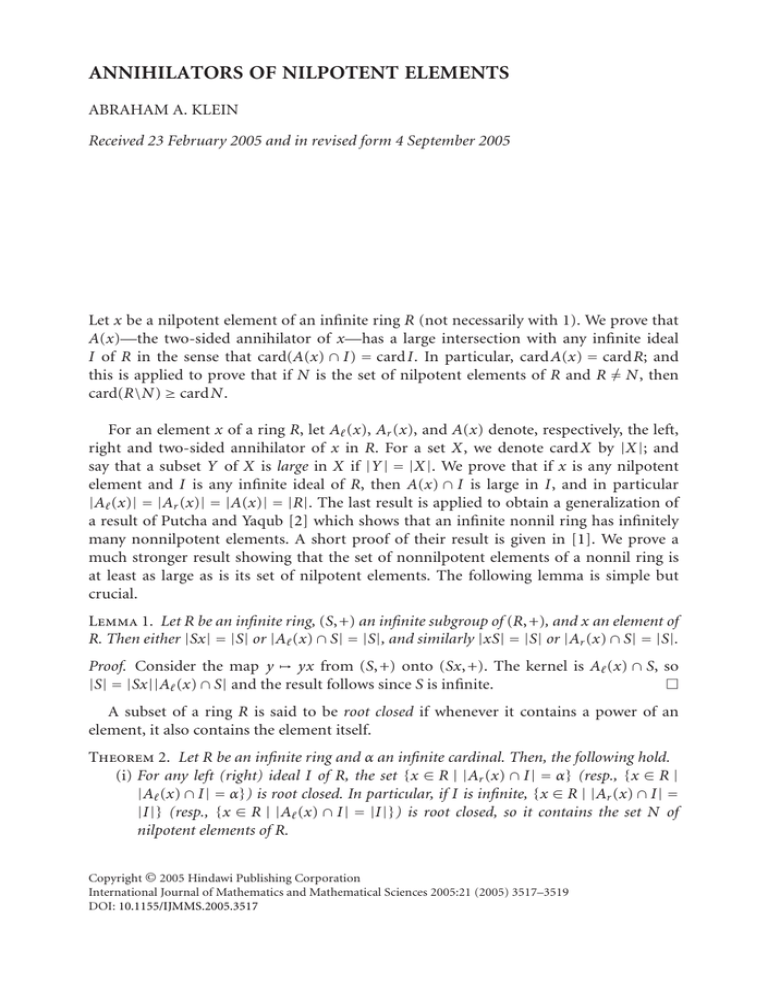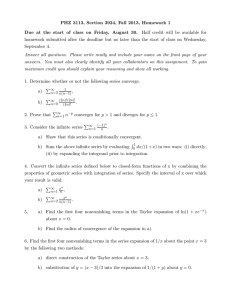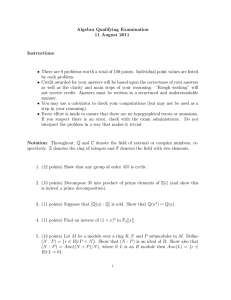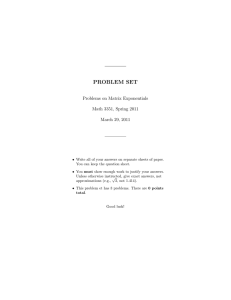ANNIHILATORS OF NILPOTENT ELEMENTS
advertisement

ANNIHILATORS OF NILPOTENT ELEMENTS
ABRAHAM A. KLEIN
Received 23 February 2005 and in revised form 4 September 2005
Let x be a nilpotent element of an infinite ring R (not necessarily with 1). We prove that
A(x)—the two-sided annihilator of x—has a large intersection with any infinite ideal
I of R in the sense that card(A(x) ∩ I) = card I. In particular, card A(x) = card R; and
this is applied to prove that if N is the set of nilpotent elements of R and R = N, then
card(R\N) ≥ card N.
For an element x of a ring R, let A (x), Ar (x), and A(x) denote, respectively, the left,
right and two-sided annihilator of x in R. For a set X, we denote cardX by |X |; and
say that a subset Y of X is large in X if |Y | = |X |. We prove that if x is any nilpotent
element and I is any infinite ideal of R, then A(x) ∩ I is large in I, and in particular
|A (x)| = |Ar (x)| = |A(x)| = |R|. The last result is applied to obtain a generalization of
a result of Putcha and Yaqub [2] which shows that an infinite nonnil ring has infinitely
many nonnilpotent elements. A short proof of their result is given in [1]. We prove a
much stronger result showing that the set of nonnilpotent elements of a nonnil ring is
at least as large as is its set of nilpotent elements. The following lemma is simple but
crucial.
Lemma 1. Let R be an infinite ring, (S,+) an infinite subgroup of (R,+), and x an element of
R. Then either |Sx| = |S| or |A (x) ∩ S| = |S|, and similarly |xS| = |S| or |Ar (x) ∩ S| = |S|.
Proof. Consider the map y → yx from (S,+) onto (Sx,+). The kernel is A (x) ∩ S, so
|S| = |Sx||A (x) ∩ S| and the result follows since S is infinite.
A subset of a ring R is said to be root closed if whenever it contains a power of an
element, it also contains the element itself.
Theorem 2. Let R be an infinite ring and α an infinite cardinal. Then, the following hold.
(i) For any left (right) ideal I of R, the set {x ∈ R | |Ar (x) ∩ I | = α} (resp., {x ∈ R |
|A (x) ∩ I | = α}) is root closed. In particular, if I is infinite, {x ∈ R | |Ar (x) ∩ I | =
|I |} (resp., {x ∈ R | |A (x) ∩ I | = |I |}) is root closed, so it contains the set N of
nilpotent elements of R.
Copyright © 2005 Hindawi Publishing Corporation
International Journal of Mathematics and Mathematical Sciences 2005:21 (2005) 3517–3519
DOI: 10.1155/IJMMS.2005.3517
3518
Annihilators of nilpotent elements
(ii) For any ideal I of R, {x ∈ R | |A(x) ∩ I | = α} is root closed. In particular, if I is
infinite, {x ∈ R | |A(x) ∩ I | = |I |} is root closed, so it contains N.
Proof. (i) Let |Ar (xn ) ∩ I | = α for some n ≥ 2 and consider xn−1 (Ar (xn ) ∩ I). By Lemma 1,
either |xn−1 (Ar (xn ) ∩ I)| = α or |Ar (xn−1 ) ∩ I | = |Ar (xn−1 ) ∩ (Ar (xn ) ∩ I)| = α. Now
xn−1 (Ar (xn ) ∩ I) ⊆ Ar (x) ∩ I ⊆ Ar (xn−1 ) ∩ I ⊆ Ar (xn ) ∩ I, so |Ar (xn−1 ) ∩ I | = α even
when |xn−1 (Ar (xn ) ∩ I)| = α. It follows by induction that |Ar (x) ∩ I | = α.
(ii) Let |A(xn ) ∩ I | = α for some n≥2. Since A (xn ) ∩ I is a left ideal and |Ar (xn ) ∩
(A (xn ) ∩ I)| = |A(xn ) ∩ I | = α, it follows by (i) that |Ar (x) ∩ (A (xn ) ∩ I)| = α =
|A (xn ) ∩ (Ar (x) ∩ I)|; and since Ar (x) ∩ I is a right ideal, we get, again by (i), that
|A (x) ∩ (Ar (x) ∩ I)| = α, namely |A(x) ∩ I | = α.
Applying the previous theorem for I = R, we obtain the following corollary.
Corollary 3. Let x be a nilpotent element of an infinite ring R, then |A (x)| = |Ar (x)| =
|A(x)| = |R|.
The previous corollary will be applied in the proof of the above-mentioned generalization of a result of Putcha and Yaqub [2]. We also need the following result.
Lemma 4. Let b be a nonnilpotent element of an infinite ring R. If R\N is infinite, then
|A (b)| ≤ |R\N | and |Ar (b)| ≤ |R\N |.
Proof. Let x ∈ A (b) ∩ N, then xb = 0 and xn = 0 for some n ≥ 1. Let m ≥ n, then (b +
x)m = bm + bm−1 x + · · · + bxm−1 . Since (bm−1 x + · · · + bxm−1 )2 = 0 and b ∈ N, b2m = 0
and (b + x)m = 0, so b + x ∈ N. Hence, the map x → b + x is 1 − 1 from A (b) ∩ N into
R\N and therefore |A (b) ∩ N | ≤ |R\N |. Since R\N is infinite, we get that |A (b)| =
|A (b)\N | + |A (b) ∩ N | ≤ |R\N | + |R\N | = |R\N |.
In a ring with 1, the map x → 1 + x from N into R\N is 1 − 1, so |R\N | ≥ |N |. The
next theorem shows that the same result holds in any nonnil ring. In particular, we get
the result of Putcha and Yaqub [2] stating that R is finite when R\N is finite and not
empty.
Theorem 5. Let R be a nonnil ring, then |R\N | ≥ |N |.
Proof. We start with R infinite. Suppose |R\N | < |N |, then |N | = |R| and |R\N | < |R|.
By the previous lemma, if b ∈ R\N, |A (b)| ≤ |R\N |, so |A (b)| < |R| and by Lemma 1,
|Rb| = |R|. Now |R| = |Rb| ≤ |Nb| + |(R\N)b| and |(R\N)b| ≤ |R\N | < |R|, so |Nb| =
|R|. Therefore, |{b + xb|x ∈ N }| = |R|, so since |R\N | < |R|, there exists x ∈ N such that
b + xb ∈ R\N, namely b + xb ∈ N. Since x ∈ N, 1 + x is formally invertible, so Ar (b +
xb) = Ar (b). By Corollary 3, |Ar (b + xb)| = |R| and by Lemma 4, |Ar (b)| ≤ |R\N | < |R|,
a contradiction.
Now let R be finite and let J be its radical. Since J is nilpotent, if a ∈ R, a + J is nilpotent
in R/J if and only if a is nilpotent, and if a ∈ N, (a + J) ∩ N = ∅. Since R/J is a finite
semisimple ring, it has 1, so at least half of its elements are nonnilpotent, hence at least
half of the distinct cosets a + J, a ∈ R, do not intersect N, and therefore at least half of the
elements of R are not nilpotent, so |R\N | ≥ |N |.
Abraham A. Klein 3519
References
[1]
[2]
H. E. Bell and A. A. Klein, On finiteness, commutativity, and periodicity in rings, Math. J.
Okayama Univ. 35 (1993), 181–188 (1995).
M. S. Putcha and A. Yaqub, Rings with a finite set of nonnilpotents, Int. J. Math. Math. Sci. 2
(1979), no. 1, 121–126.
Abraham A. Klein: Department of Pure Mathematics, School of Mathematical Sciences, The
Raymond and Beverly Sackler Faculty of Exact Sciences, Tel Aviv University, Tel Aviv 69978, Israel
E-mail address: aaklein@post.tau.ac.il







